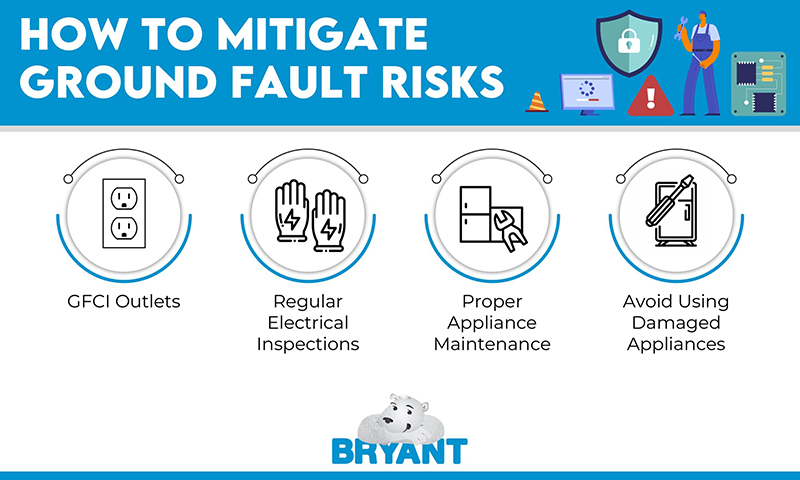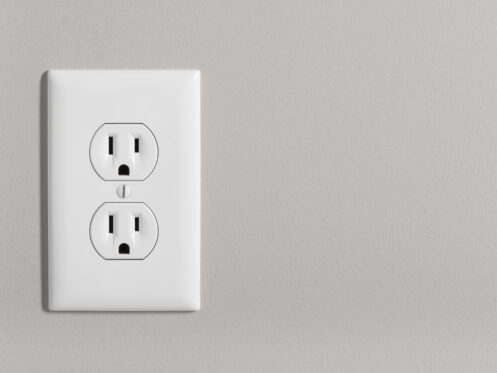A GFCI is a unique type of outlet that protects an extremely dangerous electrical issue known as a ground fault. GFCI stands for Ground Fault Circuit Interrupter. The outlet has an internal mechanism that can break or interrupt the circuit to stop the flow of electricity when a ground fault is detected. This guide will explain exactly what a ground fault is, how a GFCI outlet protects against it, and everything else you need to know about this essential equipment.
Understanding the Danger of Ground Faults
Electricity is naturally attracted to the ground, using the easiest path with the least resistance as it travels. An electrical current is essentially just the flow of negatively charged particles from one place to another. Because the ground is positively charged, it attracts the negatively charged particles in the electrical current.
A ground fault occurs when the electrical current flowing through a wire or outlet leaks out of the circuit and takes a different path that allows it to flow to the ground. This most commonly happens when an outlet or wire is exposed to water. Water is an excellent electricity conductor, which means that the current can easily flow out of the circuit through the water and then into other objects. Anything that is metal is grounded, which means the water could conduct the current into a metal electrical box and produce a ground fault.
Ground faults can also occur if a live wire in a circuit touches the ground wire or any metal object. Similarly, if you have an appliance like a toaster that has a loose or damaged wire touching the metal casing, the current would flow out and energize the toaster. If you were to touch the toaster, the current would then flow through your body into the ground.
Depending on the type of circuit, an outlet has either 15 or 20 amps of electricity flowing through it. If even 0.1 to 0.2 amps (100 to 200 milliamps) of electricity flows through the human body, the result will almost always be fatal electrocution. This is what makes ground faults so dangerous: They pose a significant risk of current flowing out of the intended path and into the body of a person, leaving them vulnerable to electrocution and death.
How GFCI Protection Works

GFCI outlets and circuit breakers continually monitor the amount of current flowing through the live and neutral wires. If the GFCI detects a sudden increase in the amperage of the current in the live wire, its internal mechanism activates almost instantly to break the circuit. GFCIs are incredibly sensitive and will typically activate even in cases of increases as little as 0.006 amps or 6 milliamps. They respond nearly instantly to stop the current from flowing with a response time of about 100 milliseconds or a tenth of a second. This ensures that GFCI outlets should always prevent electrocution if and when ground faults occur.
Why Testing GFCI Outlets Monthly Is Essential
GFCI outlets are easy to identify since they all have a Test button and a Reset button in the middle between the two receptacles. They also have an LED indicator light that shows whether the outlet is on and has power or if the GFCI has tripped and the outlet is off. A green light indicates that the outlet has power, and the light should go out if the GFCI trips.
All new GFCI outlets are required to have a self-testing feature that checks to make sure that the internal breaker is still working around once every 15 minutes. If the breaker fails to trip during this test, the LED will usually switch to red. This way you can immediately know that the GFCI is no longer working so that you can get the outlet inspected.
Whether your home has older GFCI outlets or newer self-testing GFCIs, you should always make sure to manually test each of them monthly. The reason is that the internal breaker can wear out. If this happens, it will fail to trip if a ground fault occurs and thus create a serious risk of fatal electrocution.
The green light should always immediately shut off when you press the Test button to trip the internal breaker. Testing the outlet should also cause the Reset button to pop out, and when you press the Reset button back in, the green light should come back on. If the light stays on and the Reset button doesn’t pop out when you test the outlet, the internal breaker isn’t working correctly. In this situation, you should consider the outlet unsafe to use until you have an electrician inspect it.
Which Outlets Need GFCI Protection?

Unless you’re performing extensive renovations or making major changes to your electrical system such as rewiring, you aren’t required to install GFCI outlets in all of these locations to meet the new code requirements. Nonetheless, the fact that GFCI outlets can save lives means it is something we recommend. GFCI outlets work so well that they have led to an 83% decrease in fatal electrocutions since first being introduced. Electrocutions from consumer products like appliances have also decreased by 95%.
If you’re searching for an experienced electrical company in Lexington, Louisville, Cincinnati, Bowling Green, Evansville, or the surrounding areas, look no further than Bryant Heating, Cooling, Plumbing & Electric. We’ve been serving Indiana, Kentucky, and Ohio residents since 1940 and can help if you need to install GFCI outlets or need any other electrical, plumbing, or HVAC service. Contact us today if you need to schedule a service call or inspection or if you have any questions.



